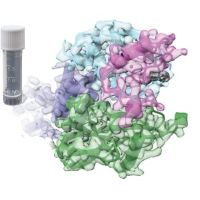Specification
| Description | Recombinant protein from the full-length sequence of Homo sapiens adenosylhomocysteinase like 1 (AHCYL1), transcript variant 1 (NM_006621). |
| Organism | Homo sapiens (Human) |
| Expression Host | Human Cells |
| Tag Info | His or DYKDDDDK. Please contact us if you need further information or require specific designed tag. |
| Purity | Greater than 90% by SDS-PAGE gel |
| Uniprot ID | O43865 |
| Entry Name | SAHH2_HUMAN |
| Gene Names | AHCYL1 DCAL IRBIT XPVKONA |
| Alternative Gene Names | DCAL IRBIT XPVKONA |
| Alternative Protein Names | S-adenosylhomocysteine hydrolase-like protein 1 (DC-expressed AHCY-like molecule) (IP(3)Rs binding protein released with IP(3)) (IRBIT) (Putative adenosylhomocysteinase 2) (S-adenosyl-L-homocysteine hydrolase 2) (AdoHcyase 2) |
| Application | Antigens, Western, ELISA and other in vitro binding or in vivo functional assays, and protein-protein interaction studies; For research & development use only! |
| Buffer | Purified protein formulated in a sterile solution of PBS buffer, pH7.2, without any preservatives |
| Endotoxin | Endotoxin level is < 0.1 ng/µg of protein (<1EU /µg) |
| Length | 530 |
| Molecular Weight(Da) | 58951 |
| Protein Sequence | (The sequence of expressed protein may have some variation from the sequence shown below. Please contact us for the exact sequence.) MSMPDAMPLPGVGEELKQAKEIEDAEKYSFMATVTKAPKKQIQFADDMQEFTKFPTKTGRRSLSRSISQSSTDSYSSAASYTDSSDDEVSPREKQQTNSKGSSNFCVKNIKQAEFGRREIEIAEQDMSALISLRKRAQGEKPLAGAKIVGCTHITAQTAVLIETLCALGAQCRWSACNIYSTQNEVAAALAEAGVAVFAWKGESEDDFWWCIDRCVNMDGWQANMILDDGGDLTHWVYKKYPNVFKKIRGIVEESVTGVHRLYQLSKAGKLCVPAMNVNDSVTKQKFDNLYCCRESILDGLKRTTDVMFGGKQVVVCGYGEVGKGCCAALKALGAIVYITEIDPICALQACMDGFRVVKLNEVIRQVDVVITCTGNKNVVTREHLDRMKNSCIVCNMGHSNTEIDVTSLRTPELTWERVRSQVDHVIWPDGKRVVLLAEGRLLNLSCSTVPTFVLSITATTQALALIELYNAPEGRYKQDVYLLPKKMDEYVASLHLPSFDAHLTELTDDQAKYLGLNKNGPFKPNYYRY |
Background
| Function | FUNCTION: Multifaceted cellular regulator which coordinates several essential cellular functions including regulation of epithelial HCO3(-) and fluid secretion, mRNA processing and DNA replication. Regulates ITPR1 sensitivity to inositol 1,4,5-trisphosphate, competing for the common binding site and acting as endogenous 'pseudoligand' whose inhibitory activity can be modulated by its phosphorylation status. Promotes the formation of contact points between the endoplasmic reticulum (ER) and mitochondria, facilitating transfer of Ca(2+) from the ER to mitochondria (PubMed:27995898). Under normal cellular conditions, functions cooperatively with BCL2L10 to limit ITPR1-mediated Ca(2+) release but, under apoptotic stress conditions, dephosphorylated which promotes dissociation of both AHCYL1 and BCL2L10 from mitochondria-associated endoplasmic reticulum membranes, inhibits BCL2L10 interaction with ITPR1 and leads to increased Ca(2+) transfer to mitochondria which promotes apoptosis (PubMed:27995898). In the pancreatic and salivary ducts, at resting state, attenuates inositol 1,4,5-trisphosphate-induced calcium release by interacting with ITPR1 (PubMed:16793548). When extracellular stimuli induce ITPR1 phosphorylation or inositol 1,4,5-trisphosphate production, dissociates from ITPR1 to interact with CFTR and SLC26A6, mediating their synergistic activation by calcium and cAMP that stimulates the epithelial secretion of electrolytes and fluid (By similarity). Also activates basolateral SLC4A4 isoform 1 to coordinate fluid and HCO3(-) secretion (PubMed:16769890). Inhibits the effect of STK39 on SLC4A4 and CFTR by recruiting PP1 phosphatase which activates SLC4A4, SLC26A6 and CFTR through dephosphorylation (By similarity). Mediates the induction of SLC9A3 surface expression produced by Angiotensin-2 (PubMed:20584908). Depending on the cell type, activates SLC9A3 in response to calcium or reverses SLC9A3R2-dependent calcium inhibition (PubMed:18829453). May modulate the polyadenylation state of specific mRNAs, both by controlling the subcellular location of FIP1L1 and by inhibiting PAPOLA activity, in response to a stimulus that alters its phosphorylation state (PubMed:19224921). Acts as a (dATP)-dependent inhibitor of ribonucleotide reductase large subunit RRM1, controlling the endogenous dNTP pool and ensuring normal cell cycle progression (PubMed:25237103). In vitro does not exhibit any S-adenosyl-L-homocysteine hydrolase activity (By similarity). {ECO:0000250|UniProtKB:B5DFN2, ECO:0000250|UniProtKB:Q80SW1, ECO:0000269|PubMed:16769890, ECO:0000269|PubMed:16793548, ECO:0000269|PubMed:18829453, ECO:0000269|PubMed:19224921, ECO:0000269|PubMed:20584908, ECO:0000269|PubMed:25237103, ECO:0000269|PubMed:27995898}. |
| Pathway | |
| Protein Families | Adenosylhomocysteinase family |
| Tissue Specificity | Expressed in dendritic cells. {ECO:0000269|PubMed:11904675}. |
QC Data
| Note | Please contact us for QC Data |
| Product Image (Reference Only) |  |

